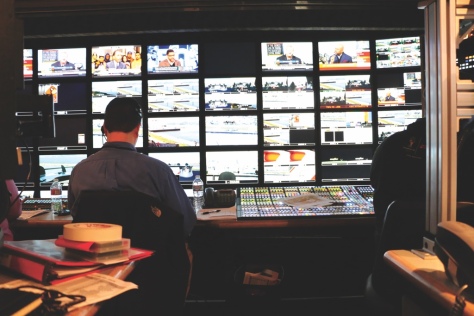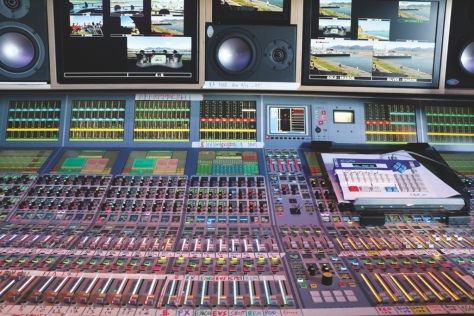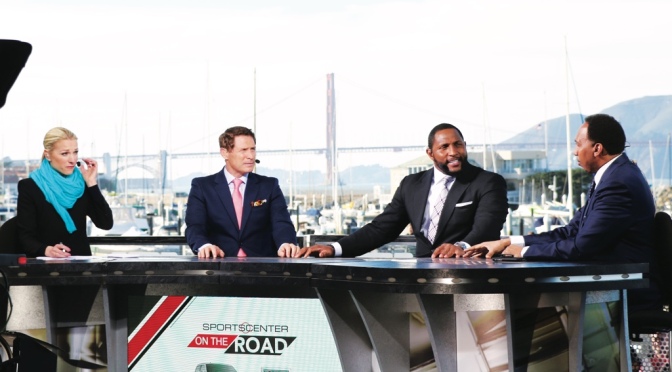John Holton
Staff Writer
The Super Bowl is the biggest American sporting event of any given year and when it comes to a city there is a massive amount of work and preparation that goes into broadcasting and reporting on it. This past Sunday the NFL was in town for the 50th Super Bowl and along with them came numerous news networks reporting on the events of Super Bowl weekend.
In addition to CBS, who broadcasted the event itself, most major news networks were in town as well to do their own reports on it. I was lucky enough to get a tour of the ESPN coverage that was taking place on the Marina Green. The setup for a broadcast of this kind was massive and the trucks, stages, and trailers took up most of the parking lot next to the Green.
I was able to go on this tour thanks to Dustin Epstein, one of ESPN’s Remote Operations Producers, who took me behind the scenes and showed how a broadcast of this type is made. In his role as producer, Dustin travels around the country to events like this and oversees the technical and operational aspects of broadcasting them. He covers events that include the Super Bowl, Monday Night Football, and the NBA Finals.
The first thing you notice when you arrive at the area where ESPN is broadcasting from is the variety of different vehicles that are involved in the production. This includes a crew lounge, a transmission truck that uses fiber to transmit the shows they film, a satellite truck in case the fiber truck fails, and even a truck that has been fully outfitted into a bathroom for the staff. This isn’t even counting the stages where shows like “Sports Center On the Road” and “Pardon the Interruption” are filmed.
While each vehicle on the site has its own important purpose, the ones at the center of it all are the 53-foot semis that serve as mobile control rooms for the entire production. These trucks are massive and extend outwards on the sides to provide even more space for the crew to work in. They’re so big that, according to Dustin, they can’t even carry their own equipment on the road, “These trucks run so heavy with all the equipment installed in them. This truck as is, is about 80,000 lbs which is the limit of what you can drive on U.S. highways. So this truck can’t carry its gear, can’t carry its camera gear or its audio gear on it because it’s too heavy so they have to buy a second truck.” That second truck sits next to the first and while some aspects of production are controlled from there it is much more empty and mainly provides storage space.
The semis at this particular broadcast are single body which means that they are capable of doing an entire show by themselves. For other events like Monday Night Football, however, even more trucks are needed. Dustin says that for an event like that they have four separate trucks that all connect to one another and are unable to function without the others. For the Super Bowl coverage the single body truck was handling around 11 cameras and 20 microphones, but at a larger event with more trucks there can be over 45 cameras and up to 200 mics.

The first room I saw inside of the truck was the audio room. This section features an absolutely massive audio board capable of handling multiple layers and 200 different channels. Don’t expect to see this kind audio board in any recording studio though, Dustin says they are made specifically for this purpose, “A lot of this gear has been built just for these types of trucks, they’re very very expensive trucks.”
Next up was the production room where the director and producer for the shows are stationed. From here they can communicate with ESPN headquarters in Bristol, Connecticut and receive information about how long they have until commercial break, and when they need to come back from break. The room also serves as the tape area, which Dustin describes as the world’s most powerful DVR. One wall is covered in monitors showing the output of every camera on the set. From here all video is recorded and the staff are also able to do simple edits that Dustin says are used for basic montages, “They can do like the montages if you watch an NBA game or an NFL game at the end of the game as they’re signing off air they show like the 30 second clips of pieces together of highlights of the game.”
Adjacent to the production room is where the engineer for the truck works. The engineer handles of the technical aspects of the trucks like how various things are patched in. He is not an ESPN employee but rather works for the company that made the truck and goes everywhere it goes. Believe it or not these semis are not owned by ESPN but rather subcontracted out by the company Game Creek Video whose entire business is the construction, maintenance, and driving of each truck.

Finally we get to the area where the stages are and everything is filmed. For this event there are two stages, one for the show “Pardon the Interruption” and the other for “SportsCenter On the Road.” At the time “Pardon the Interruption” was not being filmed so I was able to go up on the stage and look around. From one perspective it looks just like what you see on television, a desk where the hosts sit with a vista, in this case Alcatraz Island, off in the distance behind it. But behind all that is an area that looks just like any other stage, with cameras, microphones and space for cameramen and other staff to do their work.
The other stage had a show in progress and I was fortunate enough to be able to sit down inside and watch while they filmed an episode of “SportsCenter On the Road.” Anchor Lindsay Czarniak, former 49ers QB Steve Young, two time Super Bowl champion Ray Lewis, and analyst Stephen A. Smith discussed Super Bowl 50 and the day’s other sports news while cameramen, producers, and other staff went about their work beyond the camera’s view. After filming Sports Center the staff dispersed and Czarniak left the stage to interview Redskins’ quarterback Kirk Cousins and Steelers’ running back Le’Veon Bell which would be the start of a break for staff and crew until they resumed filming later in the evening.
It was truly incredible the amount of work that went into what Dustin referred to as a relatively quiet broadcast. In addition to all the crew there are dozens of others that make this type of production possible, from runners constantly traversing the city to buy things, to the workers who constructed the stages and set up the trucks. Watching SportsCenter it is nearly impossible to imagine just how much is going on behind the show that you’re seeing.
Photo courtesy of Racquel Gonzales/Foghorn

